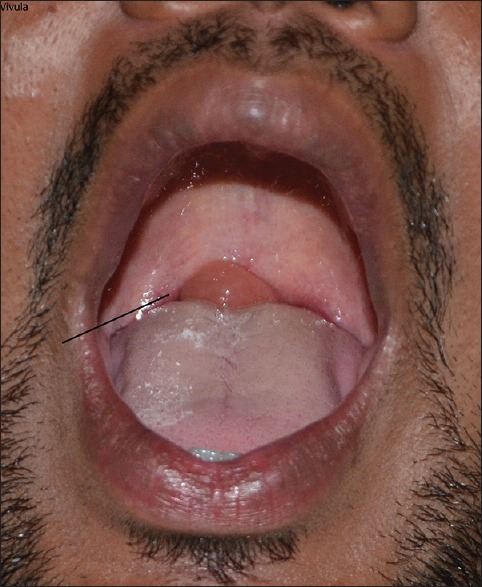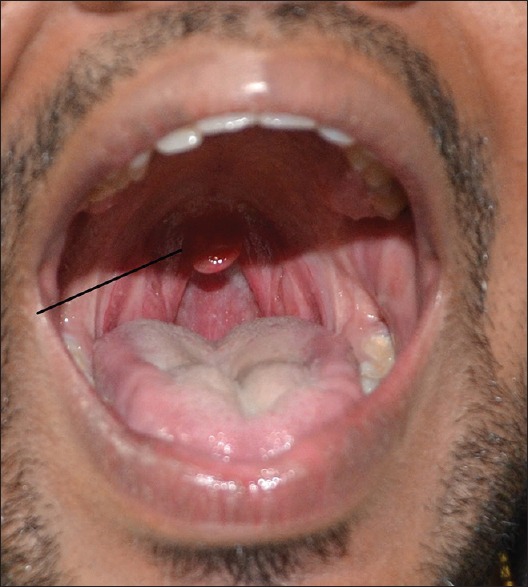Abstract
In India, eating Chinese food has become very popular. We hereby report a case who presented with angioneurotic edema of the uvula and the surrounding structures, after eating Chinese food, which resulted in severe difficulty in swallowing saliva and inability to speak.
Keywords: Monosodium glutamate, spitting, uvula
Introduction
Chinese food and soups contain monosodium glutamate (MSG) as the main addictive ingredient. A sensitive individual may suffer from headache, giddiness, sweating, abdominal pain, and urticaria within a few hours of consumption of MSG. Angioedema may be delayed up to 8–16 h after the consumption of MSG and it may persist for 24 h.[1] This delayed life-threatening effect in the form of angioedema makes diagnosis difficult.
Case Report
A 23-year-old male was brought to the General Hospital at Mahad, with complaints of difficulty in speaking, inability to swallow saliva, and continuous spitting. He strongly rejected taking sips of water and was afraid of water like a hydrophobic patient. He gave no history of snake bite or ptosis. The posterior pharynx could not be visualized, even after repeated attempts with depression of the tongue with a spatula. The uvula and surrounding structures, including the soft palate, were edematous. The uvula was touching the base of the tongue [Figure 1].
Figure 1.

On arrival, swelling of the uvula and surrounding tissues, almost closing the entry to the pharynx, touching the base of floor of the mouth.
He was weighing 80 kg, conscious cooperative and well oriented. His blood pressure was 120/80 mmHg; pulse was 88 beats/min and regular. His extremities were warm, the electrocardiograph was within normal limits, and SpO2 was 98% on ambient air. The patient said that he ate only Chinese triple fried rice for dinner the previous night 10 hours earlier. Within an hour of eating, he had giddiness, sweating, and itching all over the body which subsided without any medication. Two hours earlier he had woken up due to difficulty in swallowing and speaking out a few words. He communicated with his family with hand gestures regarding his inability to speak and swallow. There was no history of allergy or bronchial asthma.
The hemoglobin was 14 mg/dl, white cell count 13,000 per cu mm (normal 5000–10,000), eosinophils 1% (normal 1–9), neutrophils 90.9%, random blood sugar 135 mg/dl (normal 70–140), and serum IgE 917.021 IU/ml (normal 3–188).
The patient was admitted and given intravenous crystalline solution of 40mg methyl prednisolone and was monitored continuously for oxygen saturation.
There was no improvement over half an hour, so 0.30 mg of adrenaline was administered as a deep intramuscular injection over the lateral side of the thigh. The swelling of the uvula and surroundings gradually regressed. The patient no longer had drooling of saliva and was able to speak a few words. His throat looked angry around the uvula and surrounding.
On account of raised leukocyte count with neutrophilia, the patient was treated with oral Amoxycillin with clavulinate. At 16 h after the initiation of treatment, he started normal oral communication and was able to swallow liquid.
On the following day, there was a gradual reduction in the size of the uvula and surrounding inflammation. 2 days from admission, the uvula and surrounding structures including the palate returned to normal and he could swallow solids [Figure 2].
Figure 2.

Complete recovery.
Discussion
Chinese food contains MSG as the main additive ingredient and flavor enhancer. In a graded challenge, MSG alone produced angioedema, 16 h after ingestion, as reported from Australia.[1] In addition to MSG, many other food additives, including preservatives such as meta-bisulfate, soya sauce, coloring agents, such as, carmoisine, sunset yellow, tartrazine, scombroidosis, and seafood may stimulate allergic reactions.[2] Angioedema of the uvula after ingestion of MSG can be fatal unless patients and physicians are aware of unusual reaction to MSG. Many deaths can be avoided with timely diagnosis and treatment.
MSG is monosodium salt of L-glutamic acid. It is prepared by fermentation of carbohydrate sources, such as sugar beet molasses by acid hydrolysis, by the action of micrococcus glutamicus on a carbohydrate and subsequent partial neutralization, or by hydrolysis of vegetative proteins. Precipitation of severe bronchial asthma following MSG intake has been reported in two patients.[1,3]
MSG is a flavor enhancer. Large amount of MSG is used in Japanese, Chinese, and South Asian food preparation. Even free glutamate that exists in tomatoes, mushrooms, and parmesan Chinese is responsible for Chinese restaurant syndrome.[4] This syndrome was first described by Kwok in 1968.[5] The exact etiology of the “Chinese restaurant syndrome” is not known but, animal studies have shown neurotoxic and neuroexcitatory properties of MSG in the hypothalamic region of the central nervous system. The delay of uvular swelling for > 8 h such as in our patient can be explained by the time taken for the synthesis and release of hormonal factors from the hypothalamic-pituitary region.[1] A systematic review by Obayashi and Nagamura evaluating causal relationship between MSG and headache was inconclusive and suggested the need of more blinded studies.[6] However, consumption of MSG in high concentration without solid food (as in soups) was found to be associated with higher incidence of headache and other symptoms.[6,7]
Conclusion
Consumption of Chinese food is popular in India. Severe reaction to MSG, a common active ingredient in Chinese cooking may result in fatal outcome if not treated in time. Delayed occurrence of serious symptoms are to be expected.
Financial support and sponsorship
Nil.
Conflicts of interest
There are no conflicts of interest.
Acknowledgment
We are grateful to Professor Dr. Abhijit Pakhare, and Punishi Parekh, AIIMS, Bhopal and Topiwala Medical College, Mumbai, respectively, for editing the manuscript.
References
- 1.Allen DH, Baker GJ. Chinese-restaurant asthma. N Engl J Med. 1981;305:1154–5. doi: 10.1056/nejm198111053051915. [DOI] [PubMed] [Google Scholar]
- 2.Settipane GA. The restaurant syndromes. N Engl Reg Allergy Proc. 1987;8:39–46. doi: 10.2500/108854187779045330. [DOI] [PubMed] [Google Scholar]
- 3.Williams AN, Woessner KM. Monosodium glutamate ‘allergy’: Menace or myth? Clin Exp Allergy. 2009;39:640–6. doi: 10.1111/j.1365-2222.2009.03221.x. [DOI] [PubMed] [Google Scholar]
- 4.Kenney RA, Tidball CS. Human susceptibility to oral monosodium L-glutamate. Am J Clin Nutr. 1972;25:140–6. doi: 10.1093/ajcn/25.2.140. [DOI] [PubMed] [Google Scholar]
- 5.Kwok RH. Chinese-restaurant syndrome. N Engl J Med. 1968;278:796. doi: 10.1056/nejm196804042781419. [DOI] [PubMed] [Google Scholar]
- 6.Obayashi Y, Nagamura Y. Does monosodium glutamate really cause headache? A systematic review of human studies. J Headache Pain. 2016;17:54. doi: 10.1186/s10194-016-0639-4. [DOI] [PMC free article] [PubMed] [Google Scholar]
- 7.Geha RS, Beiser A, Ren C, Patterson R, Greenberger PA, Grammer LC, et al. Review of alleged reaction to monosodium glutamate and outcome of a multicenter double-blind placebo-controlled study. J Nutr. 2000;130(4S Suppl):1058S–62S. doi: 10.1093/jn/130.4.1058S. [DOI] [PubMed] [Google Scholar]


